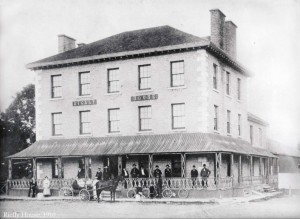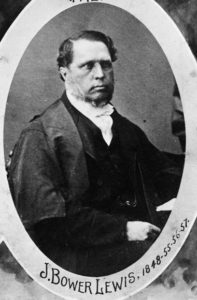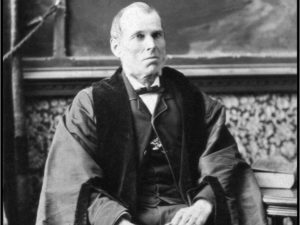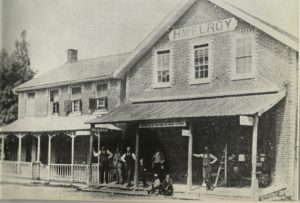To honour Richmond’s 200th anniversary, we will be posting factoids about our rich history. You should expect to see 200 pieces of information that you may or may not have already known. The topic of these posts are: #86. The Rielly House Hotel #87. Stagecoach Line #88. John Bower Lewis #89. William Pittman Lett #90. Henry McElroy’s Store
If you have a question about the source of a factoid please contact us.

courtesy GTHS
Factoid # 86. Edward Rielly settled with his wife, Sarah, on a farm near Richmond and started a hotel. There he began to raise his family, which eventually was to number 13 children. Edward was a man with big dreams and in fulfilling them he enriched his whole community. Watching the hundreds of wagons going from Prescott to the lumber shanties, and from Bytown to Perth, Edward decided to build a quality stopping-place. In 1855 he hired Mr. May of Franktown to build him a three storey, stone building at the major intersection in the village. This was not another variation of the plain Georgian style that had dominated the landscape. It instead incorporated some of the features common in the Italianate style popular at the time. The building had heavy brackets under the eaves and large quoins (cornerstones). It featured two sets of double chimneys. Although all pictures show it with a hipped roof a former owner maintained that there was evidence to show that it may originally have had a flat roof. All this style for what in 1855 was the princely sum of $10 000.
With its 22 bedrooms and excellent dining room, the hotel quickly became a favourite stopping place for travellers. Measuring 40′ X 80′ with a 30′ x 20′ annex on the rear, the building towered over its surroundings. The inside was equally imposing with a grand circular staircase leading to an upstairs parlour.
Ever the horseman, Rielly provided a large stables across the street where the arena stands today.
Edward operated the hotel until his death in 1876 when his sons Hugh and John replaced him. Unfortunately for the family, traffic through Richmond was at its height when the hotel was built and slowly but steadily declined as the horse was replaced by the iron horse.
Factoid #87. With his history of working with horses, it isn’t surprising that Edward Rielly didn’t hesitate to begin a stage coach service from the Rielly House Hotel to another Hotel, the British Lion which he owned, on Sparks St. in Ottawa The new macadamized road made the trip faster and smoother than ever before. A one-way fare could be purchased for $1.00.

(Dictionary of Canadian Biography)
Factoid #88. In the mid 1850s when Bytown, the frontier town, became Ottawa, the future capital, two men John Bower Lewis and William Pittman Lett came to prominence. Both men had grown up as sons of Richmond officers. Lewis was the eldest son of Captain John Lewis and carried on his father’s interest in politics. John Bower left the village to pursue his education and in 1841 he became a lawyer in Bytown where he emerged as a leader of the conservative, affluent population of Upper Town. He became an alderman and was first chosen to be mayor in 1848. In 1855, he was beginning a second term when Bytown became the City of Ottawa.
John Bower Lewis maintained his Richmond connections and acquired land in both the village and Goulbourn. He had close ties with his siblings: his eldest sister, Henrietta Lyon who was newly widowed in 1854 and carried on her late husband’s store; his brothers Thomas and Richard who ran the family’s Richmond business; and another sister, Catherine who married Charles Hamnett Pinhey, Lewis’s law partner and a son of Hamnett Pinhey.
As mayor of Ottawa, Lewis initiated several successful projects, but unfortunately his term will be remembered also by an act that smacked of Patronage at its worst. Dave Mullington author of The Chain of Office explained that upon assuming office Lewis fired all the municipal officials who supported his predecessor, Henry Friel, a Lower Town Catholic Reformer. Mullington says, “The firings reflected the spoils-to-the-victor attitude of the day”. He then replaced the officials with his supporters. One of his most controversial appointments was the choosing of his old boyhood friend, William Pittman Lett as City Clerk.

Factoid #89. William Pittman Lett spent his early childhood in Richmond but moved to Bytown with his widowed mother in 1827. He maintained close ties with the village where his family continued to own land. Lett stood out from many other members of the old conservative village leaders as he was an ardent Methodist and for a time edited the “Orange Lily and Protestant Vindicator” a newspaper supported by the Orange Lodge. His fiery temperment made the moderate Joseph Hinton oppose Lett’s courtship of Maria, Hinton’s daughter. The two young people eloped and eventually Hinton reconciled to their marriage and bought the couple a house near the Ottawa River in Lower Town.
Lett made a lasting contribution to Ottawa because of his writing. As City Clerk from 1855- 1891, he was responsible for the formulation of city by-laws across numerous administrations of various political leanings. He was equally renowned for his poetry, which chronicled all aspects of city and country life. He even wrote about Richmond in an 1882 poem quoted in Carleton Saga (page 78). Here are the first two verses.
“Dear old Richmond”, mid thy ruins
Memory fondly loves to dwell,
Gathering from time’s vanished shadows
Many a scene remembered well;
There I lived the days of childhood,
Hours of bliss, so fleet, so fast,
There I wandered through the wildwood,
Dreaming that the joy would last.
By the “Goodwood’s” winding current
In manhood’s morning oft I strayed,
In the green field on its border,
Many a happy day I played-
Days of bliss too quickly ended,
Like a passing flash of light,
Which from heaven had descended-
Transient, beautiful and bright!

(Carleton Saga)
Factoid # 90. In 1855, Henry McElroy started his own general store a block north of that of his father, Patrick. For the next 35 years it served as the base for the commercial and industrial enterprises built by Henry and his sons. Like most stores in the village, Henry’s home was attached to his business and while he and his family lived in those quarters, his clerk (s) often lived above the store. It was a landmark until it burned Sept. 1994 and today the site is the staff parking lot of Richmond Public School.
